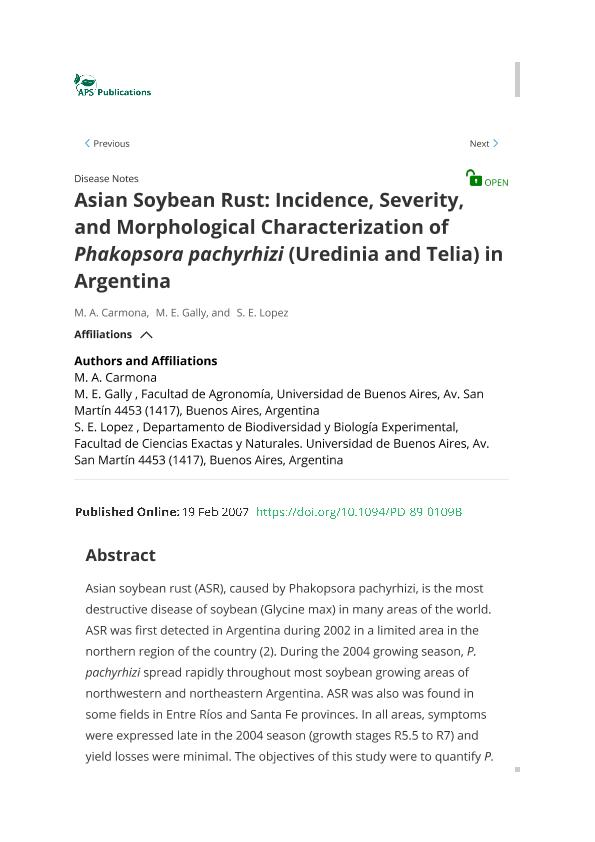Mostrar el registro sencillo del ítem
dc.contributor.author
Carmona, Marcelo Anibal

dc.contributor.author
Gally, Marcela Edith

dc.contributor.author
Lopez, Silvia Edith

dc.date.available
2017-12-05T18:35:54Z
dc.date.issued
2005-12
dc.identifier.citation
Carmona, Marcelo Anibal; Gally, Marcela Edith; Lopez, Silvia Edith; Asian Soybean Rust: Incidence, Severity, and Morphological Characterization of Phakopsora pachyrhizi (Uredinia and Telia) in Argentina; American Phytopathological Society; Plant Disease; 89; 1; 12-2005; 109-109
dc.identifier.issn
0191-2917
dc.identifier.uri
http://hdl.handle.net/11336/29769
dc.description.abstract
Asian soybean rust (ASR), caused by Phakopsora pachyrhizi, is the most destructive disease of soybean (Glycine max) in many areas of the world. ASR was first detected in Argentina during 2002 in a limited area in the northern region of the country (2). During the 2004 growing season, P. pachyrhizi spread rapidly throughout most soybean growing areas of northwestern and northeastern Argentina. ASR was also was found in some fields in Entre Ríos and Santa Fe provinces. In all areas, symptoms were expressed late in the 2004 season (growth stages R5.5 to R7) and yield losses were minimal. The objectives of this study were to quantify P. pachyrhizi infection in the canopy and morphologically characterize the fungus from fields where it had been previously detected by polymerase chain reaction (PCR) (3). Incidence (percentage of plants affected) and severity (percentage of leaf area affected, including chlorosis) were visually estimated for 10 plants arbitrarily collected (April 2004) from each of three fields located in Charata (Chacabuco), Chaco Province (Sample 1, collected in the R6 stage), La Paloma (Moreno), Santiago del Estero Province (Sample 2, stage R6 to R7), and Tolloche (Anta), Salta Province (Sample 3, stage R5.5). Disease assessments were made for the lower, middle, and upper canopy from 15 leaves per plant. The number of pustules per cm2 and uredinia per lesion were recorded from the undersides of central leaflets for each trifoliolate observed. Tissue sections were made to observe fructifications of P. pachyrhizi. Incidence of affected plants was 100% in all fields. Disease severity for Sample 1 was 45% (range 30 to 60%), 20% (10 to 30%), and 10% (5 to 20%) for the lower, middle, and upper canopy, respectively; for Sample 2: 60% (30 to 80%), 40% (25 to 50%), and 25% (15 to 40%) for the lower, middle, and upper canopy, respectively; and for Sample 3: 25% (10 to 50%), 15% (10 to 20%), and 10% (5 to 15%) for the lower, middle, and upper canopy, respectively. The number of pustules per cm2 for Sample 1 was 156/cm2 (range 88 to 200); Sample 2: 172/cm2 (128 to 232); and Sample 3: 120/cm2 (72 to 232). The number of uredinia per lesion for Sample 1 was 6 per lesion (range 1 to 15); Sample 2: 5.5 per lesion (1 to 13), and Sample 3: 2.8 per lesion (1 to 5). The two spore types that were commonly observed were urediniospores and teliospores. Telia were found on infected leaves mixed with uredinia in every sample. Urediniospores measured 16 to 22 μm (mean 18.5 μm) × 25 to 30 μm (mean 27 μm). Teliospores measured 8 to 11 μm (mean 9 μm) × 19 to 27 μm (mean 23.8 μm). Spores sizes are in the range described by Ono et al. (1). To our knowledge, this is the first report of epidemiological and morphological characterization of ASR in Argentina and the first report of the telial stage of P. pachyrhizi on soybean in South America.
dc.format
application/pdf
dc.language.iso
eng
dc.publisher
American Phytopathological Society

dc.rights
info:eu-repo/semantics/openAccess
dc.rights.uri
https://creativecommons.org/licenses/by-nc-sa/2.5/ar/
dc.subject
Soybean Rust
dc.subject
Telial Stage
dc.subject
First Report
dc.subject.classification
Agricultura

dc.subject.classification
Agricultura, Silvicultura y Pesca

dc.subject.classification
CIENCIAS AGRÍCOLAS

dc.title
Asian Soybean Rust: Incidence, Severity, and Morphological Characterization of Phakopsora pachyrhizi (Uredinia and Telia) in Argentina
dc.type
info:eu-repo/semantics/article
dc.type
info:ar-repo/semantics/artículo
dc.type
info:eu-repo/semantics/publishedVersion
dc.date.updated
2017-11-03T20:14:04Z
dc.identifier.eissn
1943-7692
dc.journal.volume
89
dc.journal.number
1
dc.journal.pagination
109-109
dc.journal.pais
Estados Unidos

dc.journal.ciudad
Minnesota
dc.description.fil
Fil: Carmona, Marcelo Anibal. Universidad de Buenos Aires. Facultad de Agronomía; Argentina
dc.description.fil
Fil: Gally, Marcela Edith. Universidad de Buenos Aires. Facultad de Agronomía; Argentina
dc.description.fil
Fil: Lopez, Silvia Edith. Consejo Nacional de Investigaciones Científicas y Técnicas. Oficina de Coordinación Administrativa Ciudad Universitaria. Instituto de Micología y Botánica. Universidad de Buenos Aires. Facultad de Ciencias Exactas y Naturales. Instituto de Micología y Botánica; Argentina
dc.journal.title
Plant Disease

dc.relation.alternativeid
info:eu-repo/semantics/altIdentifier/url/https://apsjournals.apsnet.org/doi/abs/10.1094/PD-89-0109B
dc.relation.alternativeid
info:eu-repo/semantics/altIdentifier/doi/http://dx.doi.org/10.1094/PD-89-0109B
Archivos asociados
